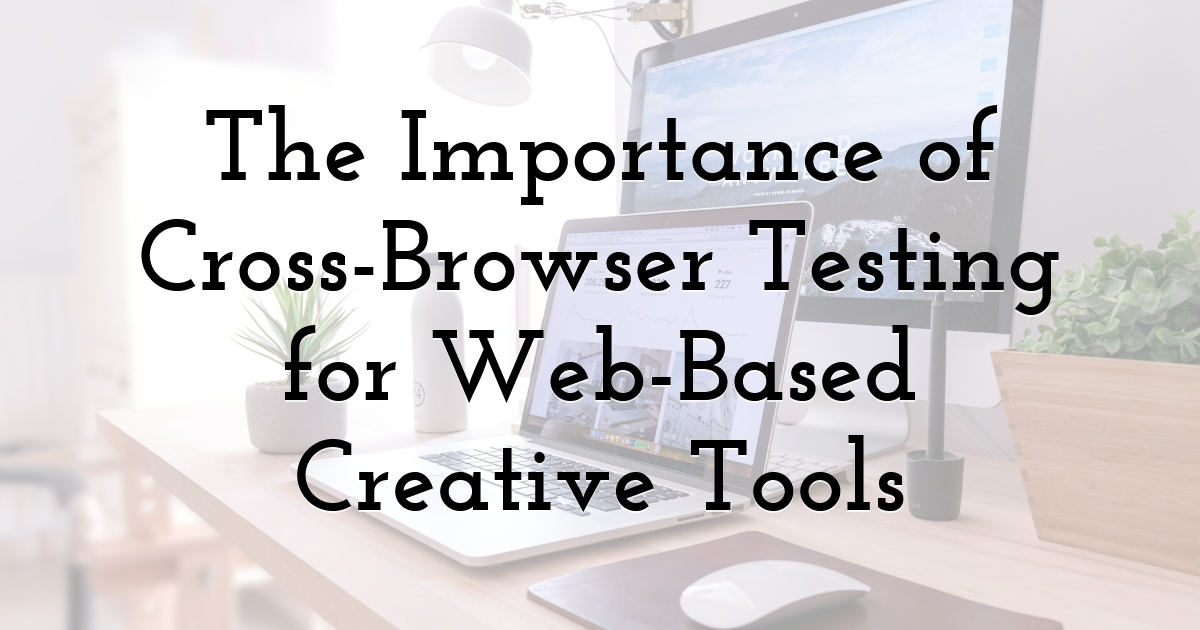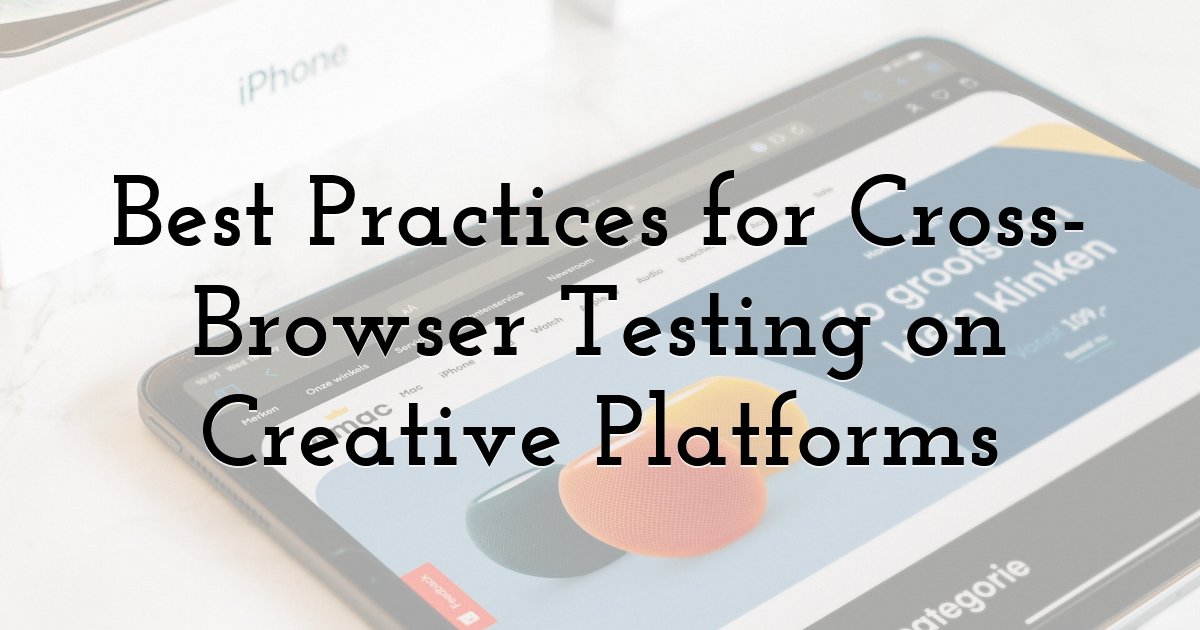How to Ensure Seamless User Experiences Across Browsers for Web-Based Creative Tools

In today’s digital world, users access web applications from a variety of devices and browsers. For web-based creative tools like image editors, animation makers, and design platforms, ensuring a seamless user experience across all browsers is crucial. Whether a user is designing graphics, creating animated logos, or generating social media posts, they expect the platform to perform consistently, regardless of their choice of browser.
Cross-browser testing plays a significant role in achieving this consistency, helping businesses deliver a high-quality experience to all users. In this article, we'll explore how cross-browser testing ensures web-based creative tools work flawlessly across different browsers and why it’s essential for user satisfaction and business success.
The Importance of Cross-Browser Testing for Web-Based Creative Tools

Creative tools like online image editors and animation makers rely heavily on the web browser to deliver their functionality. Whether users are creating graphics, adjusting photo filters, or building animated videos, the platform must behave consistently across various browsers such as Google Chrome, Firefox, Safari, and Microsoft Edge.
1. Challenges of Cross-Browser Compatibility
Every browser has its own rendering engine and standards, meaning the way content is displayed can vary significantly between browsers. This can lead to various issues, including:
- • Rendering Bugs: Elements on a page, such as buttons, images, or text, might not display correctly or may be misaligned.
- • Layout Inconsistencies: Designs or templates may look fine in one browser but appear broken or misaligned in another.
- • Functionality Failures: Features such as drag-and-drop or interactive elements might not work properly in all browsers, causing user frustration.
2. How Cross-Browser Testing Resolves These Issues
Cross-browser testing helps identify and resolve these issues by ensuring that the platform’s elements—such as design tools, image editors, and file uploaders—are rendered and function correctly across all browsers. Through cross-browser testing, developers can identify discrepancies early and fix them before they affect the user experience.
The Benefits of Cross-Browser Testing for Creative Platforms

Testing for browser compatibility not only enhances the user experience but also brings significant advantages for both the business and the user. Let’s explore the benefits of cross-browser testing in detail.
1. Improved User Experience
The most obvious benefit of cross-browser testing is ensuring a smooth, consistent experience for all users, regardless of the browser they are using. Users expect websites and applications to work seamlessly, whether they are using Chrome, Firefox, Safari, or Edge. By performing cross-browser tests, you can ensure that the interface, tools, and features work as intended across browsers, reducing the risk of user frustration due to broken layouts, images, or functionality.
2. Increased User Retention and Engagement
When users encounter bugs, layout issues, or functionality failures while using a web application, they’re more likely to abandon the platform. A consistent experience across different browsers helps keep users engaged and satisfied, improving retention rates. Creative tools that perform flawlessly across browsers can lead to a higher level of trust and loyalty from users, increasing the chances of them returning to the platform.
3. Broader Audience Reach
By ensuring that your web-based creative tool works across various browsers, you are not limiting your potential audience. Users have preferences for different browsers, and some may use less common or legacy browsers. Cross-browser testing ensures that these users can access and use your platform without issues, widening your user base and helping to grow your business.
4. Faster Time to Market
Identifying and fixing cross-browser compatibility issues early in the development cycle can save significant time. Rather than waiting until the end of development or after deployment to identify issues, cross-browser testing allows you to detect and fix discrepancies as they arise.
This proactive approach accelerates the development process and ensures that your platform is ready for launch without delays.
5. Reduced Development Costs
While cross-browser testing might initially seem like an additional step, it can actually reduce costs in the long run. By catching compatibility issues early, businesses can avoid costly fixes and redesigns after the platform has already been released. Additionally, resolving these issues during development ensures that teams don’t waste time on post-launch customer support due to browser-specific bugs.
Best Practices for Cross-Browser Testing on Creative Platforms

To effectively implement cross-browser testing for web-based creative tools, consider the following best practices:
1. Use Cross-Browser Testing Tools
Manual testing across multiple browsers can be time-consuming and prone to human error. Automated cross-browser testing tools help streamline the process by automating tests across different browsers and devices. These tools can simulate user interactions and identify discrepancies that might not be immediately visible to developers.
2. Test Key User Journeys Across Browsers
When conducting cross-browser testing, prioritize the most important user workflows, such as logging in, uploading images, using design tools, and downloading files. Ensure that these critical interactions work seamlessly across different browsers, as any issues here can significantly impact the user experience.
3. Test Across Multiple Devices and Screen Sizes
It’s important to not only test across different browsers but also different devices and screen sizes. Creative platforms are often accessed from mobile phones, tablets, and desktops, so ensuring that the platform is responsive and functional across all devices is critical. Test the platform’s performance on both smaller mobile screens and larger desktop monitors to ensure consistency in the design.
4. Check for Compatibility with Popular Browser Versions
While it’s important to test across multiple browsers, it’s equally essential to test different versions of those browsers. Popular browsers such as Chrome and Firefox regularly release new versions, and it’s crucial to ensure that your platform supports the most commonly used versions, as well as older ones that some users may still rely on.
5. Regularly Update and Retest
Browsers and web standards evolve over time, and updates may impact how your creative platform performs. Regularly retest your platform after browser updates or new version releases to ensure that the platform continues to work smoothly across all browsers.
Final Thoughts:
Cross-browser testing is essential for delivering a seamless and consistent user experience, especially for web-based creative tools where users expect full functionality and smooth design across all browsers. By addressing rendering bugs, layout inconsistencies, and functionality failures early through cross-browser testing, you can ensure that your platform remains reliable, user-friendly, and accessible to a broader audience.
Until next time, Be creative! - Pix'sTory
Recommended posts
-

5 Concepts for Creating a Persuasive Logo Design
Read More › -

Why is the Font Important for the Logo Design
Read More › -

The History of Flat Design: How Efficiency and Minimalism made the Digita...
Read More › -

10 Reasons Why You Should Use Video Marketing for Business
Read More › -

How to Improve User Experience and Get More Conversions
Read More › -

10 Timeless Web Design Trends
Read More ›
